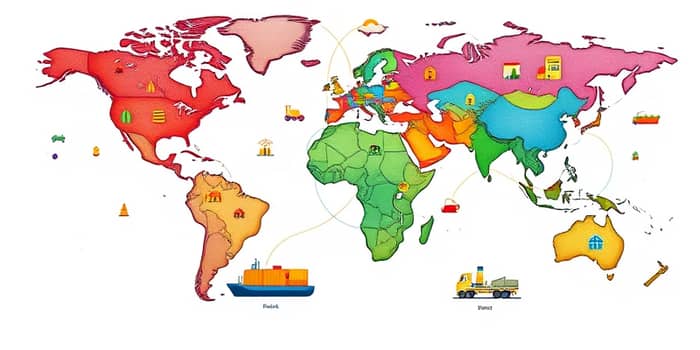
Global supply chains have faced unprecedented shocks in recent years, from pandemics to geopolitical conflicts. Businesses are under pressure to ensure continuity and adapt swiftly when disruptions strike.
The COVID-19 pandemic disrupted production lines and revealed the fragility of far-reaching networks, prompting executives to reevaluate long-standing sourcing policies and embrace supply chain localization strategies to build more resilient systems.
By moving operations closer to end customers, firms can harness agility, reduce transit times, and better align with local market needs. This shift represents a strategic realignment rather than a temporary reaction.
This article explores the rapid adoption of localized supply chains, examining data trends, strategic approaches, technological enablers, and the benefits and challenges companies will encounter.
Industry projections indicate a major shift toward regionalization. The localization sector is set to achieve $75.7 billion in 2025, growing at a steady 7% annual rate as firms seek to minimize overseas vulnerabilities.
A 2025 BCG study forecasts that by 2030, regional supply chains will make up 50% of global trade, a steep rise from 30% in 2020, underscoring a profound transformation in trade patterns.
The market for supply chain management software mirrors this evolution, expanding from $21.95 billion in 2023 to an expected $30.91 billion by 2026, driven by demand for digital visibility and analytics tools.
Below is a snapshot of key metrics shaping the localization landscape:
Geopolitical uncertainty has surged, marked by tariffs, sanctions, and shifting trade agreements. Firms are pursuing risk mitigation through supplier diversification and diversifying sourcing bases closer to home.
Persistent border disruptions, such as bottlenecks at key crossings, underline the importance of nearshoring to reduce transit vulnerabilities and maintain uninterrupted production flows.
Modern consumers demand faster delivery and unique, tailored products. Brands that adapt supply networks to local preferences can capture market share by offering region-specific assortments.
Sustainability goals amplify this trend. Companies relocating production have achieved 10% lower logistics-related emissions, cutting transport distances and aligning operations with ambitious ESG objectives.
Multishoring—a hybrid of onshoring, nearshoring, and far-shoring—balances cost optimization with supply assurance, allowing firms to pivot between regions when needed.
Supplier diversification remains essential. Over 90% of US companies are adopting multi-supplier models to spread risk, and 75% are ensuring that disruptions in one location won’t halt operations.
Advanced supplier relationship management platforms integrate performance metrics, quality controls, and compliance checks, making it easier to coordinate complex regional networks.
Data-driven localization uses local sales figures, demographic insights, and external indicators like weather patterns to adjust inventory and product offerings with precision.
Artificial intelligence and automation streamline critical processes. AI-driven demand forecasting can reduce prediction errors by up to 50%, aligning production schedules with real-time market signals.
Automated warehouses boost throughput and accuracy in picking and packing, which is vital when managing smaller, region-specific stock-keeping units.
Real-time supply chain visibility platforms, powered by IoT and cloud analytics, allow firms to track goods end to end, identify delays instantly, and reroute shipments proactively.
Blockchain applications are emerging to reduce compliance costs by 15% through secure, immutable records that verify product provenance and tariff classifications in localized setups.
Localized networks enhance corporate agility, enabling companies to pivot quickly in response to disruptions such as natural disasters, political unrest, or sudden demand spikes.
Cost control improves over time. Although initial capital expenditures rise due to new facilities and diversified sourcing, firms gain predictable pricing and escape extreme currency fluctuations.
Tailored offerings for local markets foster deeper customer connections. Custom packaging, regional flavor profiles, and culturally relevant marketing improve brand resonance and loyalty.
Environmental impact is also reduced. By shortening transport legs, companies can meet or exceed sustainability targets and appeal to eco-conscious stakeholders globally.
Expanding regional operations increases managerial complexity. A broader web of suppliers requires robust coordination and oversight to maintain quality and compliance.
Infrastructure readiness varies widely. Firms may invest heavily in new warehouses, distribution centers, and last-mile delivery solutions to uphold service levels across markets.
Regulatory compliance poses ongoing challenges. Navigating diverse tariff regimes, labor laws, and environmental rules demands specialized expertise, as evidenced by 25% of firms facing tariff fines in 2024.
Labor market dynamics also differ significantly. Wage rates, skill availability, and regulations can impact cost structures and necessitate ongoing adjustments to operational strategies.
“Today’s consumers expect a more unique, personalized experience,” notes an industry expert. “By tailoring logistics and the supply chain to different markets, localization allows businesses to appeal directly to specific customer segments.”
According to a recent study, companies that invest early in regional supply chains will gain competitive advantage through faster response times and enhanced brand loyalty.
By 2030, regional supply chains may account for half of global trade, marking a paradigm shift in how goods are produced, moved, and consumed worldwide.
Continued investment in the global supply chain management market—projected to reach $30.91 billion by 2026—and the AI segment, expected to hit $20 billion by 2028, will further underpin localization initiatives.
As regulatory frameworks evolve to support regional trade corridors and new technologies like digital twins and augmented reality in logistics mature, supply chain localization will remain a defining strategy for resilient, sustainable growth.
References













